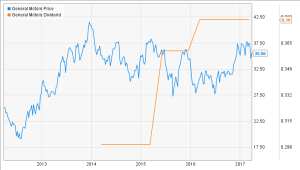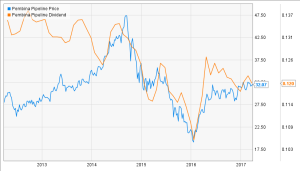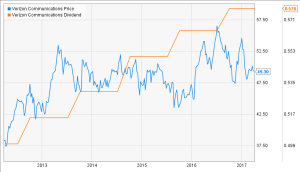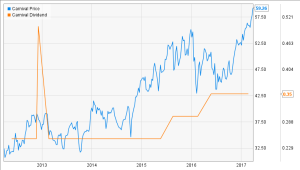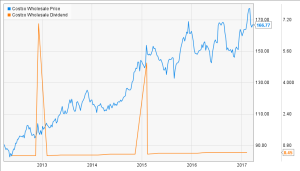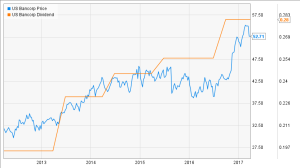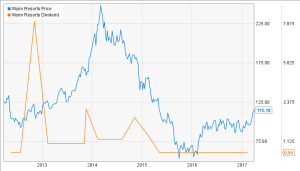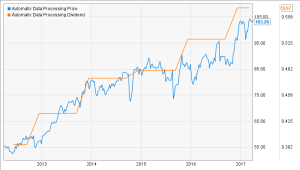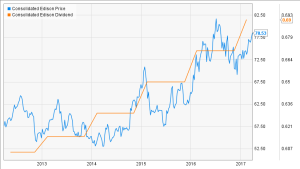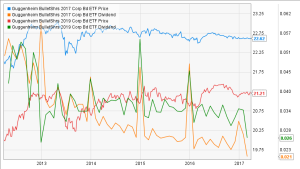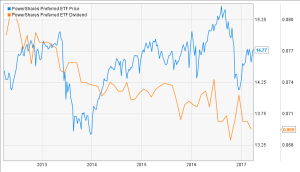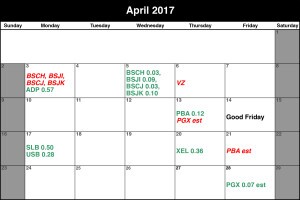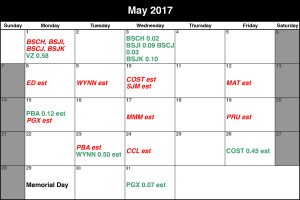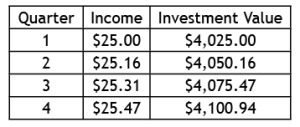We’re adding a 100-year dividend payer to the Safe Income Tier, and saying sayonara to a perpetual underperformer. We also take a look at the incredible power of dividend reinvestment.
Cautiously Bullish—CDI
[premium_html_toc post_id="127285"]
Cautiously Bullish
Some cracks appeared in the market this month, first in small- and mid-cap stocks, then in the financials, and finally in the broad market last Tuesday. But just as investors were preparing themselves for a deeper correction—and the Dow’s eight-day losing streak was making non-financial headlines—markets bounced back yesterday: the Dow and Nasdaq gained 0.7%, while the S&P 500 rose 0.6%.
There are still pockets of weakness: we’re going to continue to handle financials with care, and energy stocks are being held back by low oil prices. We’re also selecting a more conservative stock to add to our Safe Income Tier this month. But overall, cautiously bullish remains the appropriate stance.
[highlight_box]What To Do Now: We tightened up our portfolio this month, moving a couple of stocks to Hold, cutting Costco (COST) loose and taking some profits in Xcel Energy (XEL) and U.S. Bancorp (USB). And today, we’re selling J.M. Smucker (SJM), which has been underperforming for a long time. After these latest moves, we’re pretty comfortable with our portfolio. If you still need to do a little pruning yourself, take advantage of this bounce to make the moves. Alternatively, if you’re underinvested, now is the time to start positions in strong stocks. I expect Carnival (CCL), Wynn (WYNN) and Home Depot (HD) to continue to do well over the coming months, while bargain hunters will find good opportunities in the High Yield Tier. And this month’s new addition is a perfect long-term buy for safe income investors. [/highlight_box]
Featured Buy
3M (MMM)
This month we’re adding 3M (MMM) to the portfolio’s Safe Income Tier. The stock offers unparalleled free cash flow generation and a very reliable 2.5% yield for investors seeking safe income.
The Company
I’ve always associated 3M with Post-it Notes, but consumer products account for only 15% of 3M’s sales. The rest of the company’s revenue comes from the industrial sector (35% of sales), health care sector (19%) and multi-industry sales of safety equipment and electronics (20% and 15%). In short, 3M products are everywhere, from welding masks, to kitchen sponges, to electronic stethoscopes, to the coating sprayed on road signs to make them more reflective.
This diversity of applications and customers lends stability to 3M’s revenues. In addition, consumables make up almost 50% of sales, which means lots of repeat purchases, improving the predictability of revenues. Slower economic growth can still affect revenues—sales fell 8% during the recession, and declined 5% in 2015 and 0.5% in 2016 due to unfavorable changes in exchange rates and lower demand in energy and industrial markets.
However, 3M has improved operating margins by several percentage points in recent years by combining divisions, making strategic acquisitions and divestitures, and implementing lean business practices. As a result, earnings per share were unaffected by the recent revenue declines. In fact, EPS have grown each year since 2009 by an average of 8.8% per year. By converting over 100% of net income to free cash flow, 3M has managed to grow free cash flow per share even more quickly—by an average of 10% per year in each of the last five years.
In 2017, management plans to continue to grow earnings faster than revenue by deploying a new enterprise resource planning system worldwide (adding five to 10 cents to EPS) and continuing to improve utilization and productivity (adding 10 to 20 cents to EPS). Share repurchases are also expected to reduce the number of shares outstanding by 2% to 3%, increasing EPS by 15 to 25 cents.
For the full year 2017, management expects organic sales growth of 1%–3% (in local currency) will fuel 4%–8% expansion in EPS, to $8.45–$8.80. Analysts’ consensus estimate of 5.6% EPS growth this year is near the low end of that range, while estimates for 2018 show an uptick to 8.8% growth year-over-year. Over the next five years, analysts expect earnings to rise about 9% per year, a moderate acceleration from the 7% pace of the last five years.
Of course, changes in exchange rates and commodity prices can affect results unpredictably. The stronger U.S. dollar may remain a financial headwind this year (it dilutes the impact of international sales growth on 3M’s dollar-denominated quarterly results). And while raw material costs are currently expected to decline this year, providing a 10- to 15-cent benefit to EPS, changes in prices of commodities (oil is an important feedstock for many 3M products) are unpredictable.
However, 3M’s management has a proven track record of delivering free cash flow and earnings growth regardless of global economic conditions.
The Dividend
3M’s reliable cash flow has enabled the company to pay dividends consistently for 100 years, with increases every year since 1959. Over the past three decades, the annual increases have averaged a solid 8% per year, while the last five annual dividend increases have averaged 15%. Going forward, management expects to grow the dividend in line with earnings.
There is one yellow flag in 3M’s dividend ratings: The company’s current payout ratio is 54%, the highest it’s been in 10 years. The company has historically maintained a payout ratio of 35% to 45%.
However, because of its almost unparalleled scores in other areas, 3M still earns a perfect Dividend Safety Rating of 10.0 and a very strong Dividend Growth Rating of 9.2.
The Stock
3M has been in a long-term uptrend since the recession ended in 2009. The stock traded sideways for most of 2015 as investors waited for sales growth to return, resumed its advance in 2016 and is now trading at all-time highs.
At this point, 3M isn’t undervalued—the stock trades at 24 times current earnings and 22 times forward earnings. But that’s the premium you pay for a high-quality blue chip stock with a 100-year dividend history that has beat earnings estimates in each of the last four quarters.
Lastly, a note to investors worried about 3M’s high price: Remember, it’s not how many shares you own, it’s the dollar value. (You can also consider using dividend reinvestment, which often allows you to buy fractional shares, to gradually increase your position size over time. See this month’s educational section on the last page for more information.)
We’ll be adding 3M to the Safe Income Tier of our portfolio at the stock’s average price on Monday (the first trading day of April). Investors looking to add a high-quality stock and reliable income stream to their portfolio can buy here or try to establish a position on a pullback of a couple of points. The company’s next earnings announcement is on April 25.
| 3M(MMM) | ||
|---|---|---|
| Price: 191 52-week range: 163.12-193.50 Market cap: $113.49 billion P/E: 23 | Current yield: 2.5% Annual dividend: $4.70 Most recent dividend: $1.18 Dividend Safety rating: 10.0 Dividend Growth rating: 9.2 | |
| Dividends since: 1917 Consecutive years of increases: 58 Qualified dividends? Yes | Payment Schedule: Quarterly Next ex-dividend date: May 17, 2017 est. | |
Portfolio at a Glance
Closing Prices on March 28, 2017
Portfolio Updates
High Yield Tier
The investments in our High Yield tier have been chosen for their high current payouts. These ?investments will often be riskier or have less capital appreciation potential than those in our other ?two tiers, but they’re appropriate for investors who want to generate maximum income from their? portfolios right now.
HOLD – GameStop (GME 22– yield 7.0%) – We moved GME to Hold in a special bulletin sent Friday, after the stock plunged 11% post-earnings. GameStop actually beat fourth-quarter and full-year EPS estimates, but revenues fell short and management issued disappointing 2017 EPS guidance. Their flat sales guidance is in line with analysts’ estimates, but management’s anticipated EPS range of $3.10–$3.40 (representing a 9% to 18% drop from 2016) is well below analysts’ previous average estimate of $3.76. The low guidance includes a few one-time impacts, including higher taxes and a change in the fiscal year. But the primary culprit is low video game sales—a story that’s already well known, and not something GameStop can do much about. GameStop’s growth businesses—collectibles, technology stores and digital—continue to thrive. While the guidance is disappointing, the stock has already begun to rebound. GME has found support at this level before, in November. The company’s buyback program is another likely source of support here. And, with the stock’s yield now over 7%, and its P/E at 5.6, bargain hunters are probably stepping in as well. We’ll continue to Hold. Next ex-div date: June 6, 2017 est.
HOLD – General Motors (GM 36 – yield 4.3%) – GM fell through the bottom of its multi-month trading range during last Tuesday’s selloff, kicked around 34 for a bit, and then rebounded strongly yesterday. At this level, GM is trading at 5.8 times current earnings, and only 5.6 times forward earnings. Preliminary numbers suggest auto sales remained strong this month; TrueCar estimates that GM’s sales rose 5.5% year-over-year, to 226,000 units, giving GM a 16.8% market share. GM is a Hold for high yield investors. Next ex-div date: June 7, 2017 est.
HOLD – Mattel (MAT 25 – yield 6.0%) – MAT hit a new 52-week low last Wednesday, but has since rebounded 1.9%. I’m concerned about the lack of an obvious support level for the stock, and earnings estimates’ decline over the past month. The toy company did just get a new CEO in February, who is expected to infuse some tech-industry experience in Mattel’s turnaround. We’ll Hold for now, but you should use an appropriate stop loss in your own portfolio. Next ex-div date: May 12, 2017 est.
BUY – Pembina Pipeline (PBA 32 – yield 4.5%) – PBA held up well to this month’s slide in oil stocks and last week’s shakeout. The Canadian pipeline company pays monthly dividends. (Note that the volatility visible in the dividend line on the chart is due to changes in exchange rates; PBA declares dividends in Canadian dollars so their value in U.S. dollars will vary.) High yield investors who want to start a position can do so here. Next ex-div date: April 21, 2017 est.
BUY – Verizon (VZ 49 – yield 4.7%) – After outperforming early last week, telecoms stumbled on Wednesday and posted additional losses on Monday. Over the past five trading days, VZ is down 1.9%, dragging our total return down to -1%. The stock remains well within its multi-month trading range though, so investors looking for a high and reliable income stream at a reasonable price can still start positions here. Next ex-div date: April 6, 2017
Dividend Growth Tier
To be chosen for the Dividend Growth tier, investments must have a strong history of dividend increases and indicate both good potential for and high prioritization of continued dividend growth.
BUY – Carnival (CCL 59 – yield 2.4%) – CCL reported estimate-beating first quarter earnings yesterday, and opened at new all-time highs. Adjusted EPS of $0.38 beat estimates by three cents. Revenue rose 3.8% year-over-year, to $3.79 billion, $10 million above the consensus estimate. Changes in fuel costs and foreign exchange are both working against the company this year, but were offset by stronger demand and higher ticket prices in the first quarter. Management said bookings for the rest of the year are “well ahead” of where they were last year, and are selling at considerably higher prices. Based on the better-than-expected first quarter performance, management increased their full-year EPS guidance, from $3.30–$3.60 to $3.50–$3.70. CCL is a Buy on pullbacks for dividend growth investors. Next ex-div date: May 24, 2017 est.
SOLD – Costco (COST 167 – yield 1.1%) – We sold Costco near the beginning of the month, after the stock gapped down on earnings and failed to rebound quickly. In addition to the technical weakness, earnings estimates have declined, and the retail sector is in the doghouse again. We bought COST at 112 in February 2014, and sold half our position at 149 in February 2016, for a 33% profit. We sold the rest of our position on March 10 (in a Special Bulletin) at the day’s average price of 165.74, for a profit of about 48.6%. Our total return, including dividends, was 49%. If you haven’t yet, sell COST, and put the money to work in other, healthier stocks. Next ex-div date: May 10, 2017 est.
HOLD – Prudential Financial (PRU 106 – yield 2.8%) – After last Tuesday’s sharp pullback, PRU and its peers traded sideways through the end of the week, saw further losses Monday, and then rebounded slightly yesterday. The bounce wasn’t particularly impressive, but we still haven’t seen any downward earnings revisions for PRU, so we’ll keep the stock on Hold a bit longer. Next ex-div date: May 19, 2017 est.
HOLD – Schlumberger (SLB 78 – yield 2.6%) – After seven straight days of losses, SLB bounced on Monday and Tuesday, ultimately ending the last five days of trading about flat. Over the past month, SLB is down about 2.6%, and earnings estimates are stable. We’ll keep a mental stop around 75, where the stock bounced in June and September. For now, SLB is a Hold. Next ex-div date: June 2, 2017 est.
HOLD – U.S. Bancorp (USB 53 – yield 2.1%) – I downgraded USB to Hold in last week’s update, and we also sold a third of our position, booking a 19% profit (price only). Like PRU, the stock traded sideways through the end of last week, but gapped down again on Monday morning and failed to regain much ground yesterday. But, as with PRU, we haven’t seen any downward earnings revisions—in fact, two analysts bumped up their estimates this week. USB is a Hold. The stock trades ex-dividend today. Next ex-div date: March 29, 2017
BUY – Wynn Resorts (WYNN 115 – yield 1.7%) – After breaking out of its 11-month trading range to the upside last Monday, WYNN has tacked on an additional 3% over the past five trading days. The stock is now trading at a new 52-week high, but this is most likely just the beginning. The big catalyst here is accelerating improvement in Macau’s tourism sector (although the addition of two pro sports teams to Las Vegas helps, too). WYNN is a buy on pullbacks for medium-term dividend growth and growth investors with moderate risk tolerance. Next ex-div date: May 9, 2017 est.
Safe Income Tier
The Safe Income tier of our portfolio holds long-term positions in high-quality stocks and other investments that generate steady income with minimal volatility and low risk. These positions are appropriate for all investors, but are meant to be held for the long term, primarily for income—don’t buy these thinking you’ll double your money in a year.
HOLD – Automatic Data Processing (ADP 103 – yield 2.2%) – After being rebuffed by overhead resistance at 105 last week, ADP has pulled back to its 50-day moving average, currently at 102. ADP is a reliable dividend payer but remains on Hold until we see confirmation that the stock’s uptrend is intact—like a breakout through 105.
HOLD – Consolidated Edison (ED 79 – yield 3.5%) – ED gained 1% this week. Interest rates have actually pulled back since the Fed’s mid-March rate hike, and utilities remain in demand. The sector is a relative beneficiary of a strong dollar (since most operations are purely U.S.) and could benefit from tax cuts; many utilities, including ConEd, pay the top corporate tax rate. Hold.
BUY – Guggenheim BulletShares 2017 Corporate Bond ETF (BSCH 23 – yield 1.4%)
BUY – Guggenheim BulletShares 2018 High Yield Corporate Bond ETF (BSJI 25 – yield 4.0%)
BUY – Guggenheim BulletShares 2019 Corporate Bond ETF (BSCJ 21 – yield 1.8%)
BUY – Guggenheim BulletShares 2020 High Yield Corporate Bond ETF (BSJK 24 – yield 4.8%)
The high yield funds in our bond ladder pulled back this month as oil prices fell and treasury yields rose, but the moderation in both since the Fed rate hike has caused a partial rebound. Oil prices affect the junk bond market because many of the least-creditworthy issuers of high yield debt are small energy companies. Another period of low oil prices could cause defaults among those issuers, and losses in junk bond ETFs. In addition, higher benchmark interest rates will raise borrowing costs for businesses, further strapping less-creditworthy borrowers. And of course, rising interest rates cause prices of existing bonds to fall. Regardless, investors with a bond ladder in place can hold, or even use this pullback as a buying opportunity, since these funds’ defined maturity dates protect investors’ principal as long as you buy at a reasonable price.
BUY – Home Depot (HD 147 – yield 2.4%) – HD hit a new 52-week high last Monday, and is now pulling back slightly. The stock’s 50-day moving average is down at 143; a longer consolidation would give it a chance to catch up. The housing market remains strong; home prices rose at the fastest pace since 2014 in January. And consumer confidence hit its highest level since December 2000 in March. If you’ve been waiting to buy HD, now is a good time.
BUY – PowerShares Preferred Portfolio (PGX 15 – yield 5.7%) – PGX is a preferred share ETF; preferred stocks are typically less affected by interest rate changes than bonds. The fund usually trades in a fairly low volatility range between 14 and 16, and pays monthly dividends of about seven cents per share. Investors looking to add reliable monthly income (without capital appreciation) to their portfolio can buy PGX when it is trading below 15.
SELL – J.M. Smucker (SJM 133 – yield 2.3%) – SJM fell another 1.2% over the past five trading days. Investors aren’t exactly running for the exits, but there’s a slow exodus underway. I said last week that we needed to see support develop soon if SJM was going to keep its place in our portfolio, and it hasn’t materialized. So we’ll cut SJM loose now. We’ll sell at today’s average price; our total return will probably be around 6% (about half from dividends, half from price appreciation).
BUY – Xcel Energy (XEL 45 – yield 3.2%) – We sold a third of our XEL last week, booking a profit of 46% (price only). The stock has risen every day since, although it may face some resistance here, at 45. The utility remains a long-term Buy for its reliable low-single digit earnings growth and consistent dividend payments.
Dividend Calendar
Ex-Dividend Dates are in RED and italics. Dividend Payments Dates are in GREEN. See the Guide to Cabot Dividend Investor for an explanation of how dates are determined and what estimated dates mean.
Should You Be Reinvesting Your Dividends?
Dividend reinvestment is one of the most powerful weapons in the income investor’s toolbox. You’ve probably heard it said that compound interest is the most powerful force in the universe (a quote attributed to Einstein, almost certainly erroneously), and dividend reinvestment takes advantage of some of the same forces—namely time and compounding.
When you choose to reinvest your dividends, each stock’s dividend payment is used to buy new shares of that same stock, at the market rate. You then start earning dividends on those new shares, and those dividends get turned into more shares, and so on and so forth. Over time, the number of shares you own and the size of the dividend checks you receive every quarter will both gradually increase, without you doing a thing.
Most brokers will reinvest your dividends for you for free, and the purchases will be completed without fees (although you will owe income taxes on the dividend amount). Alternatively, you can often sign up for a Dividend Reinvestment Plan, or DRIP, directly with the dividend-paying company. Company-operated DRIPs allow investors to buy shares directly from the company, and in exchange, dividends are automatically reinvested in the company’s stock, sometimes at below-market prices. Today’s new addition to the Safe Income tier, 3M (MMM), offers a DRIP that also allows investors to invest an additional $10 to $10,000 in cash every quarter.
Those are the two most obvious benefits of dividend reinvesting: You can increase your position for free, without fees, and it’s automatic, so you don’t have to think about it. If a stock is high quality and you plan to own it for a long time, dividend reinvestment is a great passive way to increase your exposure over time. Sure, you could collect the dividends and then manually invest them in something else, but a good habit that takes no effort is easier to keep up than one that takes a little effort.
However, the third big reason to reinvest dividends, and the less obvious one, is actually the most powerful. It’s the power of compounding, the same action that makes compound interest so powerful.
When you reinvest dividends, you increase the size of your investment, thus also increasing the dividends you’ll receive next time. So each reinvestment will be slightly larger than the last (assuming dividend payments don’t decrease). Just as with compound interest, you’ll be surprised how quickly those little additions can add up!
For example, let’s say you own 100 shares of a $40 stock with a 2.5% yield. That means the company pays $1.00 per share in dividends each year, or 25 cents per quarter. This table shows how your dividend income and the size of your investment will change over the first year.
As you can see, reinvesting that first $25 increases your second dividend payment by 16 cents, because you now own another $25 worth of dividend-paying stock. By the end of the year, your quarterly dividends have increased to $25.47, and the value of your investment has increased by $100.94—that $100 is simply the dividend payments, which you would have earned whether or not you chose to reinvest. But the extra 94 cents is “dividends on dividends,” which you earned thanks to reinvesting.
Ninety-four cents may not seem like a lot, which is why the second important force at work here is time. After 10 years, your annual dividend income from this same position will be $126.31, up from $100.94 the first year. (That’s a yield on cost of 3.16%, based on your initial investment.) The value of your investment will be $5,132.11, without any appreciation in the stock price. One-hundred thirty-two dollars and eleven cents of that is thanks to your dividends on dividends. (If you hadn’t reinvested, the value of your investment would still be $4,000, and you would have collected $1,000 in dividends, for a total return of $5,000. The difference between that and $5,132.11 is what we’re calling dividends on dividends.)
After 30 years, your investment will be worth $8,448.26, and you’ll be earning $207.95 per year in dividends—you’ve more than doubled your original income, and are earning a yield on cost of 5.2%.
And that’s all without a single increase in the stock price, or the dividend. If you buy a dividend aristocrat that increases its dividend every year, your returns improve at every step. If the company in the example above increases its dividend by 5% per year, your annual income will reach $200 at the end of 10 years, instead of 30. After 30 years, your annual income will be a whopping $2,218.83, and your investment will be worth $22,022.24. Not bad for a stock that doesn’t go up!
Of course, if you buy a stock that does goes up over 30 years (as most of them do!) you’ll be even happier. While your reinvestments will occur at higher prices, the capital appreciation on those new shares more than makes up for it. (If you’re intrigued, search for a dividend reinvestment calculator online and punch in some real numbers.)
Reasons Not To Reinvest Dividends
While dividend reinvestment is powerful, there are a couple of reasons why you might not want to reinvest your dividends.
The most obvious reason is that you need the income. If you’re in the “distribution” phase of your investing life, dividends are a perfect source of passive income. Income from qualified dividends is taxed at the long-term capital gains rate (currently 15% for investors who are in the 25% to 35% tax bracket for ordinary income, 0% for taxpayers in a lower bracket and 20% for those in the highest bracket). So if you’re going to be looking to your portfolio for income every month anyway, it makes sense to have that cash deposited in your account.
You might also choose to stop reinvesting your dividends for allocation reasons. Reinvesting your dividends will cause your stock positions to grow over time, and if you’ve owned a particular issue for a long time, it may already be a large enough percentage of your portfolio. Higher-yielding positions will grow faster, which can throw your allocations out of whack pretty quickly. So once a stock position is as big as you want it to get (for now) feel free to turn off dividend reinvestment for that position, and either enjoy the extra income or save up the cash to invest in other stocks.
Finally, you may also have stock-specific reasons not to reinvest dividends—if a stock is temporarily overvalued, or you simply don’t want to buy any more of it at current prices.
But bottom line, reinvesting dividends is a surprisingly powerful tool to passively improve your investment returns, as long as it fits with your investing goals.
[premium_html_footer]
Your next issue will be published April 26, 2017
Cabot Wealth Network • 176 North Street • Salem MA 01970 • 978-745-5532
Neither Cabot Wealth Network nor our employees are compensated by the companies whose stocks we recommend. Sources of information are believed to be reliable, but are in no way guaranteed to be complete or without error. Recommendations, opinions or suggestions are given with the understanding that subscribers acting on the information assume all risks. © Cabot Wealth Network. Copying and/or electronic transmission of this report is a violation of U.S. copyright law. For the protection of our subscribers, if copyright laws are violated, the subscription will be terminated. To subscribe or for information on our privacy policy, call 978-745-5532, visit www.cabotwealth.com or write to support@cabotwealth.com.
[/premium_html_footer]





